Analyzing Leadership Styles and Employee Motivation at G&K
VerifiedAdded on 2021/04/30
|20
|5269
|472
Report
AI Summary
This report provides an in-depth analysis of leadership styles and their impact on employee motivation within G&K Limited, a retail business. The report identifies the prevalent command and control leadership style as a contributor to employee dissatisfaction and proposes alternative human resource practices. It examines G&K's management approaches, organizational structure, and HR strategies, highlighting areas for improvement. The study recommends strategies for employee motivation, including both intrinsic and extrinsic factors, as well as specific HR practices such as job security, effective hiring processes, self-managed teams, and competitive compensation. The report concludes with actionable recommendations to improve leadership effectiveness, enhance employee engagement, and align HR practices with organizational goals, ultimately aiming to improve customer service and overall business performance. The report also touches on Herzberg's Two-Factor Theory and its applications to employee motivation.
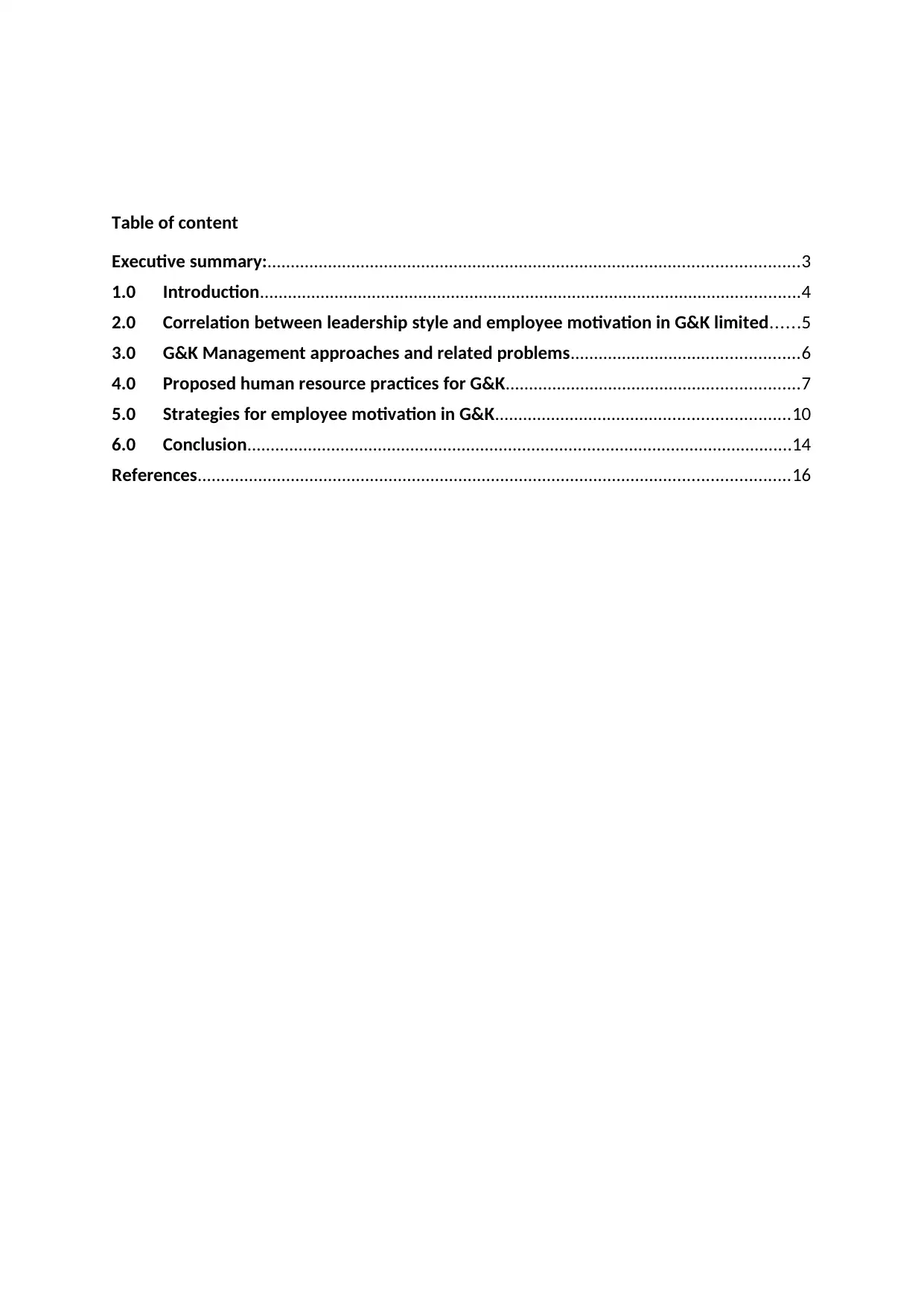
Table of content
Executive summary:..................................................................................................................3
1.0 Introduction....................................................................................................................4
2.0 Correlation between leadership style and employee motivation in G&K limited......5
3.0 G&K Management approaches and related problems.................................................6
4.0 Proposed human resource practices for G&K...............................................................7
5.0 Strategies for employee motivation in G&K...............................................................10
6.0 Conclusion.....................................................................................................................14
References...............................................................................................................................16
Executive summary:..................................................................................................................3
1.0 Introduction....................................................................................................................4
2.0 Correlation between leadership style and employee motivation in G&K limited......5
3.0 G&K Management approaches and related problems.................................................6
4.0 Proposed human resource practices for G&K...............................................................7
5.0 Strategies for employee motivation in G&K...............................................................10
6.0 Conclusion.....................................................................................................................14
References...............................................................................................................................16
Paraphrase This Document
Need a fresh take? Get an instant paraphrase of this document with our AI Paraphraser
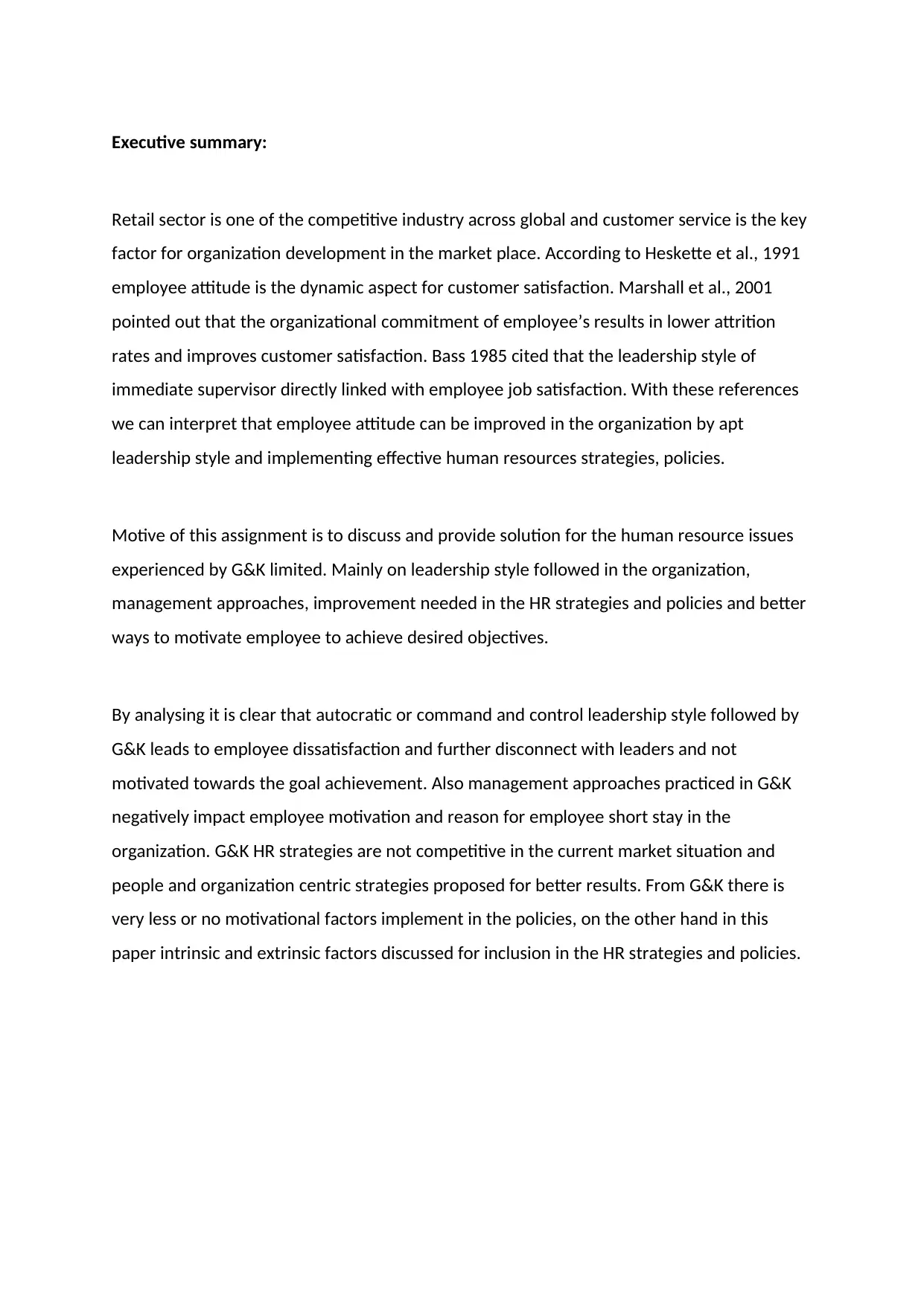
Executive summary:
Retail sector is one of the competitive industry across global and customer service is the key
factor for organization development in the market place. According to Heskette et al., 1991
employee attitude is the dynamic aspect for customer satisfaction. Marshall et al., 2001
pointed out that the organizational commitment of employee’s results in lower attrition
rates and improves customer satisfaction. Bass 1985 cited that the leadership style of
immediate supervisor directly linked with employee job satisfaction. With these references
we can interpret that employee attitude can be improved in the organization by apt
leadership style and implementing effective human resources strategies, policies.
Motive of this assignment is to discuss and provide solution for the human resource issues
experienced by G&K limited. Mainly on leadership style followed in the organization,
management approaches, improvement needed in the HR strategies and policies and better
ways to motivate employee to achieve desired objectives.
By analysing it is clear that autocratic or command and control leadership style followed by
G&K leads to employee dissatisfaction and further disconnect with leaders and not
motivated towards the goal achievement. Also management approaches practiced in G&K
negatively impact employee motivation and reason for employee short stay in the
organization. G&K HR strategies are not competitive in the current market situation and
people and organization centric strategies proposed for better results. From G&K there is
very less or no motivational factors implement in the policies, on the other hand in this
paper intrinsic and extrinsic factors discussed for inclusion in the HR strategies and policies.
Retail sector is one of the competitive industry across global and customer service is the key
factor for organization development in the market place. According to Heskette et al., 1991
employee attitude is the dynamic aspect for customer satisfaction. Marshall et al., 2001
pointed out that the organizational commitment of employee’s results in lower attrition
rates and improves customer satisfaction. Bass 1985 cited that the leadership style of
immediate supervisor directly linked with employee job satisfaction. With these references
we can interpret that employee attitude can be improved in the organization by apt
leadership style and implementing effective human resources strategies, policies.
Motive of this assignment is to discuss and provide solution for the human resource issues
experienced by G&K limited. Mainly on leadership style followed in the organization,
management approaches, improvement needed in the HR strategies and policies and better
ways to motivate employee to achieve desired objectives.
By analysing it is clear that autocratic or command and control leadership style followed by
G&K leads to employee dissatisfaction and further disconnect with leaders and not
motivated towards the goal achievement. Also management approaches practiced in G&K
negatively impact employee motivation and reason for employee short stay in the
organization. G&K HR strategies are not competitive in the current market situation and
people and organization centric strategies proposed for better results. From G&K there is
very less or no motivational factors implement in the policies, on the other hand in this
paper intrinsic and extrinsic factors discussed for inclusion in the HR strategies and policies.
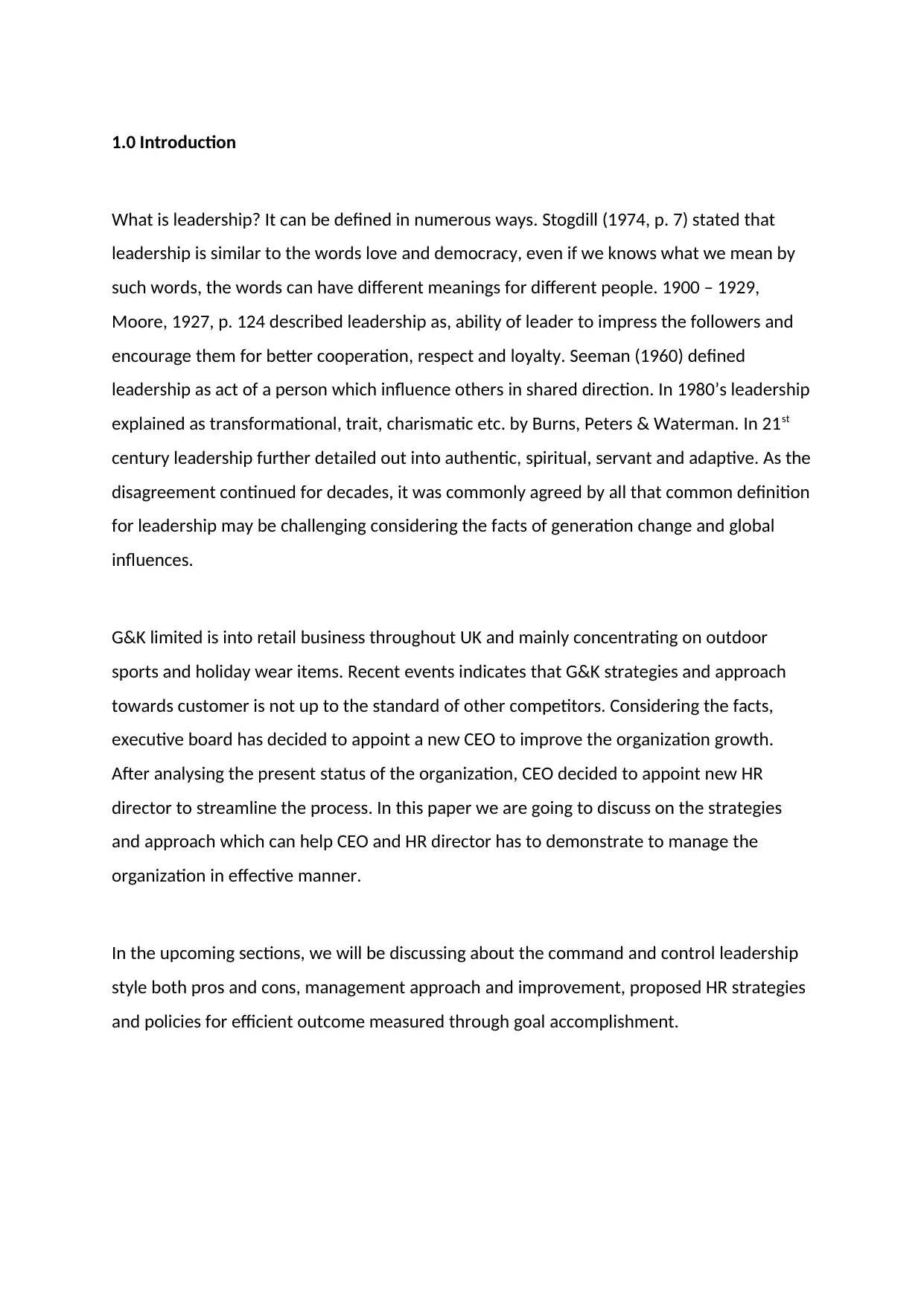
1.0 Introduction
What is leadership? It can be defined in numerous ways. Stogdill (1974, p. 7) stated that
leadership is similar to the words love and democracy, even if we knows what we mean by
such words, the words can have different meanings for different people. 1900 – 1929,
Moore, 1927, p. 124 described leadership as, ability of leader to impress the followers and
encourage them for better cooperation, respect and loyalty. Seeman (1960) defined
leadership as act of a person which influence others in shared direction. In 1980’s leadership
explained as transformational, trait, charismatic etc. by Burns, Peters & Waterman. In 21st
century leadership further detailed out into authentic, spiritual, servant and adaptive. As the
disagreement continued for decades, it was commonly agreed by all that common definition
for leadership may be challenging considering the facts of generation change and global
influences.
G&K limited is into retail business throughout UK and mainly concentrating on outdoor
sports and holiday wear items. Recent events indicates that G&K strategies and approach
towards customer is not up to the standard of other competitors. Considering the facts,
executive board has decided to appoint a new CEO to improve the organization growth.
After analysing the present status of the organization, CEO decided to appoint new HR
director to streamline the process. In this paper we are going to discuss on the strategies
and approach which can help CEO and HR director has to demonstrate to manage the
organization in effective manner.
In the upcoming sections, we will be discussing about the command and control leadership
style both pros and cons, management approach and improvement, proposed HR strategies
and policies for efficient outcome measured through goal accomplishment.
What is leadership? It can be defined in numerous ways. Stogdill (1974, p. 7) stated that
leadership is similar to the words love and democracy, even if we knows what we mean by
such words, the words can have different meanings for different people. 1900 – 1929,
Moore, 1927, p. 124 described leadership as, ability of leader to impress the followers and
encourage them for better cooperation, respect and loyalty. Seeman (1960) defined
leadership as act of a person which influence others in shared direction. In 1980’s leadership
explained as transformational, trait, charismatic etc. by Burns, Peters & Waterman. In 21st
century leadership further detailed out into authentic, spiritual, servant and adaptive. As the
disagreement continued for decades, it was commonly agreed by all that common definition
for leadership may be challenging considering the facts of generation change and global
influences.
G&K limited is into retail business throughout UK and mainly concentrating on outdoor
sports and holiday wear items. Recent events indicates that G&K strategies and approach
towards customer is not up to the standard of other competitors. Considering the facts,
executive board has decided to appoint a new CEO to improve the organization growth.
After analysing the present status of the organization, CEO decided to appoint new HR
director to streamline the process. In this paper we are going to discuss on the strategies
and approach which can help CEO and HR director has to demonstrate to manage the
organization in effective manner.
In the upcoming sections, we will be discussing about the command and control leadership
style both pros and cons, management approach and improvement, proposed HR strategies
and policies for efficient outcome measured through goal accomplishment.
⊘ This is a preview!⊘
Do you want full access?
Subscribe today to unlock all pages.

Trusted by 1+ million students worldwide
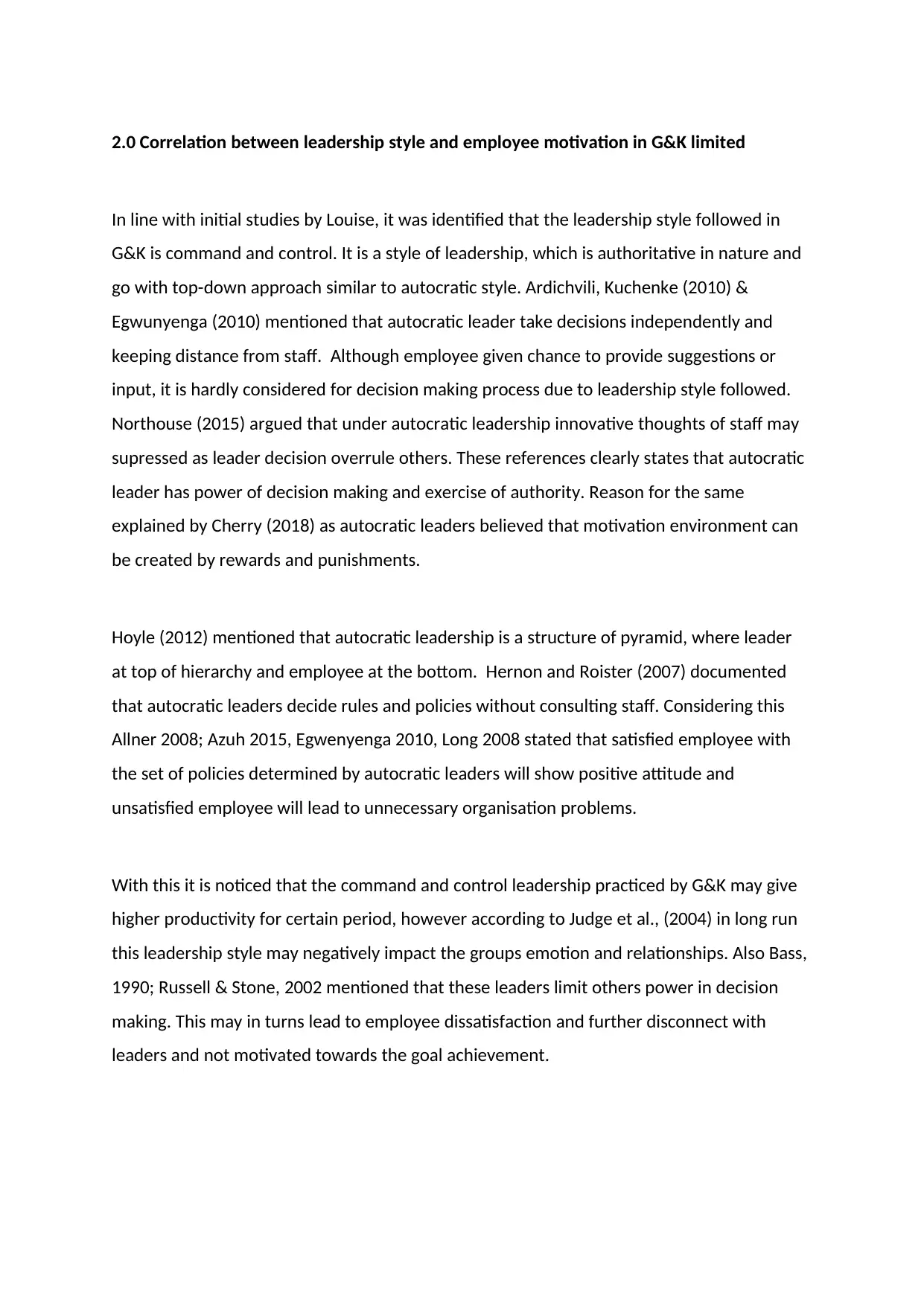
2.0 Correlation between leadership style and employee motivation in G&K limited
In line with initial studies by Louise, it was identified that the leadership style followed in
G&K is command and control. It is a style of leadership, which is authoritative in nature and
go with top-down approach similar to autocratic style. Ardichvili, Kuchenke (2010) &
Egwunyenga (2010) mentioned that autocratic leader take decisions independently and
keeping distance from staff. Although employee given chance to provide suggestions or
input, it is hardly considered for decision making process due to leadership style followed.
Northouse (2015) argued that under autocratic leadership innovative thoughts of staff may
supressed as leader decision overrule others. These references clearly states that autocratic
leader has power of decision making and exercise of authority. Reason for the same
explained by Cherry (2018) as autocratic leaders believed that motivation environment can
be created by rewards and punishments.
Hoyle (2012) mentioned that autocratic leadership is a structure of pyramid, where leader
at top of hierarchy and employee at the bottom. Hernon and Roister (2007) documented
that autocratic leaders decide rules and policies without consulting staff. Considering this
Allner 2008; Azuh 2015, Egwenyenga 2010, Long 2008 stated that satisfied employee with
the set of policies determined by autocratic leaders will show positive attitude and
unsatisfied employee will lead to unnecessary organisation problems.
With this it is noticed that the command and control leadership practiced by G&K may give
higher productivity for certain period, however according to Judge et al., (2004) in long run
this leadership style may negatively impact the groups emotion and relationships. Also Bass,
1990; Russell & Stone, 2002 mentioned that these leaders limit others power in decision
making. This may in turns lead to employee dissatisfaction and further disconnect with
leaders and not motivated towards the goal achievement.
In line with initial studies by Louise, it was identified that the leadership style followed in
G&K is command and control. It is a style of leadership, which is authoritative in nature and
go with top-down approach similar to autocratic style. Ardichvili, Kuchenke (2010) &
Egwunyenga (2010) mentioned that autocratic leader take decisions independently and
keeping distance from staff. Although employee given chance to provide suggestions or
input, it is hardly considered for decision making process due to leadership style followed.
Northouse (2015) argued that under autocratic leadership innovative thoughts of staff may
supressed as leader decision overrule others. These references clearly states that autocratic
leader has power of decision making and exercise of authority. Reason for the same
explained by Cherry (2018) as autocratic leaders believed that motivation environment can
be created by rewards and punishments.
Hoyle (2012) mentioned that autocratic leadership is a structure of pyramid, where leader
at top of hierarchy and employee at the bottom. Hernon and Roister (2007) documented
that autocratic leaders decide rules and policies without consulting staff. Considering this
Allner 2008; Azuh 2015, Egwenyenga 2010, Long 2008 stated that satisfied employee with
the set of policies determined by autocratic leaders will show positive attitude and
unsatisfied employee will lead to unnecessary organisation problems.
With this it is noticed that the command and control leadership practiced by G&K may give
higher productivity for certain period, however according to Judge et al., (2004) in long run
this leadership style may negatively impact the groups emotion and relationships. Also Bass,
1990; Russell & Stone, 2002 mentioned that these leaders limit others power in decision
making. This may in turns lead to employee dissatisfaction and further disconnect with
leaders and not motivated towards the goal achievement.
Paraphrase This Document
Need a fresh take? Get an instant paraphrase of this document with our AI Paraphraser
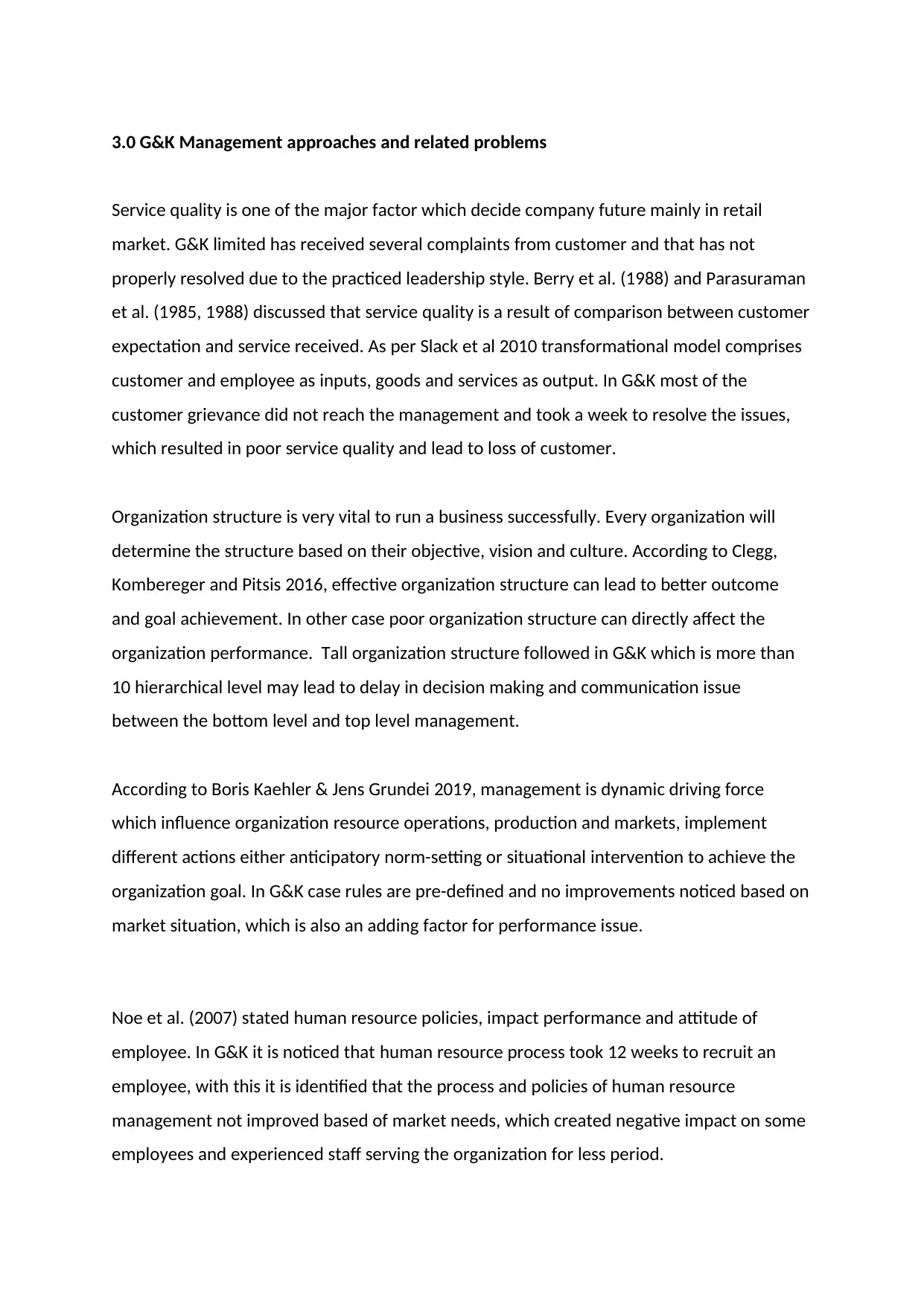
3.0 G&K Management approaches and related problems
Service quality is one of the major factor which decide company future mainly in retail
market. G&K limited has received several complaints from customer and that has not
properly resolved due to the practiced leadership style. Berry et al. (1988) and Parasuraman
et al. (1985, 1988) discussed that service quality is a result of comparison between customer
expectation and service received. As per Slack et al 2010 transformational model comprises
customer and employee as inputs, goods and services as output. In G&K most of the
customer grievance did not reach the management and took a week to resolve the issues,
which resulted in poor service quality and lead to loss of customer.
Organization structure is very vital to run a business successfully. Every organization will
determine the structure based on their objective, vision and culture. According to Clegg,
Kombereger and Pitsis 2016, effective organization structure can lead to better outcome
and goal achievement. In other case poor organization structure can directly affect the
organization performance. Tall organization structure followed in G&K which is more than
10 hierarchical level may lead to delay in decision making and communication issue
between the bottom level and top level management.
According to Boris Kaehler & Jens Grundei 2019, management is dynamic driving force
which influence organization resource operations, production and markets, implement
different actions either anticipatory norm-setting or situational intervention to achieve the
organization goal. In G&K case rules are pre-defined and no improvements noticed based on
market situation, which is also an adding factor for performance issue.
Noe et al. (2007) stated human resource policies, impact performance and attitude of
employee. In G&K it is noticed that human resource process took 12 weeks to recruit an
employee, with this it is identified that the process and policies of human resource
management not improved based of market needs, which created negative impact on some
employees and experienced staff serving the organization for less period.
Service quality is one of the major factor which decide company future mainly in retail
market. G&K limited has received several complaints from customer and that has not
properly resolved due to the practiced leadership style. Berry et al. (1988) and Parasuraman
et al. (1985, 1988) discussed that service quality is a result of comparison between customer
expectation and service received. As per Slack et al 2010 transformational model comprises
customer and employee as inputs, goods and services as output. In G&K most of the
customer grievance did not reach the management and took a week to resolve the issues,
which resulted in poor service quality and lead to loss of customer.
Organization structure is very vital to run a business successfully. Every organization will
determine the structure based on their objective, vision and culture. According to Clegg,
Kombereger and Pitsis 2016, effective organization structure can lead to better outcome
and goal achievement. In other case poor organization structure can directly affect the
organization performance. Tall organization structure followed in G&K which is more than
10 hierarchical level may lead to delay in decision making and communication issue
between the bottom level and top level management.
According to Boris Kaehler & Jens Grundei 2019, management is dynamic driving force
which influence organization resource operations, production and markets, implement
different actions either anticipatory norm-setting or situational intervention to achieve the
organization goal. In G&K case rules are pre-defined and no improvements noticed based on
market situation, which is also an adding factor for performance issue.
Noe et al. (2007) stated human resource policies, impact performance and attitude of
employee. In G&K it is noticed that human resource process took 12 weeks to recruit an
employee, with this it is identified that the process and policies of human resource
management not improved based of market needs, which created negative impact on some
employees and experienced staff serving the organization for less period.
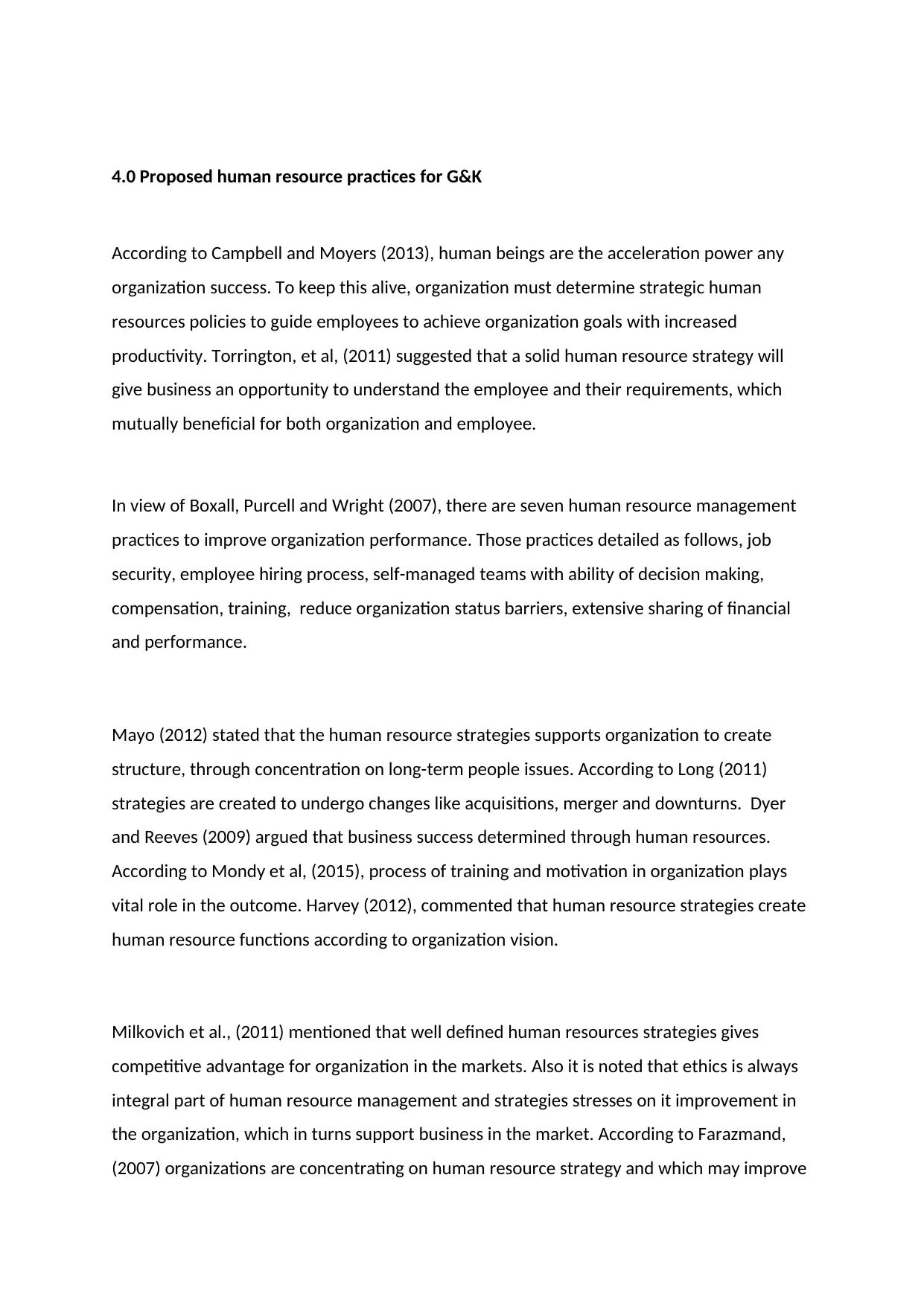
4.0 Proposed human resource practices for G&K
According to Campbell and Moyers (2013), human beings are the acceleration power any
organization success. To keep this alive, organization must determine strategic human
resources policies to guide employees to achieve organization goals with increased
productivity. Torrington, et al, (2011) suggested that a solid human resource strategy will
give business an opportunity to understand the employee and their requirements, which
mutually beneficial for both organization and employee.
In view of Boxall, Purcell and Wright (2007), there are seven human resource management
practices to improve organization performance. Those practices detailed as follows, job
security, employee hiring process, self-managed teams with ability of decision making,
compensation, training, reduce organization status barriers, extensive sharing of financial
and performance.
Mayo (2012) stated that the human resource strategies supports organization to create
structure, through concentration on long-term people issues. According to Long (2011)
strategies are created to undergo changes like acquisitions, merger and downturns. Dyer
and Reeves (2009) argued that business success determined through human resources.
According to Mondy et al, (2015), process of training and motivation in organization plays
vital role in the outcome. Harvey (2012), commented that human resource strategies create
human resource functions according to organization vision.
Milkovich et al., (2011) mentioned that well defined human resources strategies gives
competitive advantage for organization in the markets. Also it is noted that ethics is always
integral part of human resource management and strategies stresses on it improvement in
the organization, which in turns support business in the market. According to Farazmand,
(2007) organizations are concentrating on human resource strategy and which may improve
According to Campbell and Moyers (2013), human beings are the acceleration power any
organization success. To keep this alive, organization must determine strategic human
resources policies to guide employees to achieve organization goals with increased
productivity. Torrington, et al, (2011) suggested that a solid human resource strategy will
give business an opportunity to understand the employee and their requirements, which
mutually beneficial for both organization and employee.
In view of Boxall, Purcell and Wright (2007), there are seven human resource management
practices to improve organization performance. Those practices detailed as follows, job
security, employee hiring process, self-managed teams with ability of decision making,
compensation, training, reduce organization status barriers, extensive sharing of financial
and performance.
Mayo (2012) stated that the human resource strategies supports organization to create
structure, through concentration on long-term people issues. According to Long (2011)
strategies are created to undergo changes like acquisitions, merger and downturns. Dyer
and Reeves (2009) argued that business success determined through human resources.
According to Mondy et al, (2015), process of training and motivation in organization plays
vital role in the outcome. Harvey (2012), commented that human resource strategies create
human resource functions according to organization vision.
Milkovich et al., (2011) mentioned that well defined human resources strategies gives
competitive advantage for organization in the markets. Also it is noted that ethics is always
integral part of human resource management and strategies stresses on it improvement in
the organization, which in turns support business in the market. According to Farazmand,
(2007) organizations are concentrating on human resource strategy and which may improve
⊘ This is a preview!⊘
Do you want full access?
Subscribe today to unlock all pages.

Trusted by 1+ million students worldwide
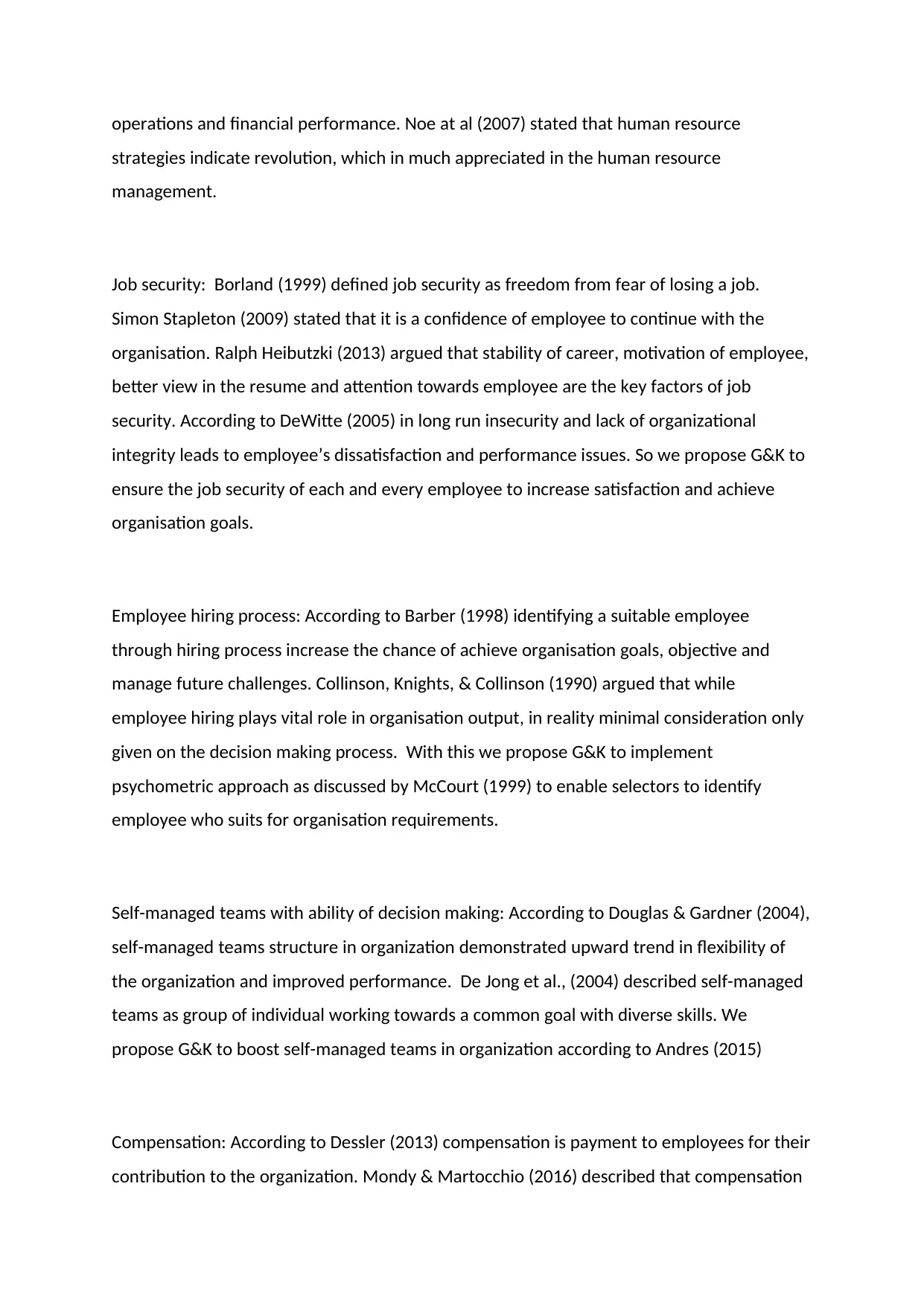
operations and financial performance. Noe at al (2007) stated that human resource
strategies indicate revolution, which in much appreciated in the human resource
management.
Job security: Borland (1999) defined job security as freedom from fear of losing a job.
Simon Stapleton (2009) stated that it is a confidence of employee to continue with the
organisation. Ralph Heibutzki (2013) argued that stability of career, motivation of employee,
better view in the resume and attention towards employee are the key factors of job
security. According to DeWitte (2005) in long run insecurity and lack of organizational
integrity leads to employee’s dissatisfaction and performance issues. So we propose G&K to
ensure the job security of each and every employee to increase satisfaction and achieve
organisation goals.
Employee hiring process: According to Barber (1998) identifying a suitable employee
through hiring process increase the chance of achieve organisation goals, objective and
manage future challenges. Collinson, Knights, & Collinson (1990) argued that while
employee hiring plays vital role in organisation output, in reality minimal consideration only
given on the decision making process. With this we propose G&K to implement
psychometric approach as discussed by McCourt (1999) to enable selectors to identify
employee who suits for organisation requirements.
Self-managed teams with ability of decision making: According to Douglas & Gardner (2004),
self-managed teams structure in organization demonstrated upward trend in flexibility of
the organization and improved performance. De Jong et al., (2004) described self-managed
teams as group of individual working towards a common goal with diverse skills. We
propose G&K to boost self-managed teams in organization according to Andres (2015)
Compensation: According to Dessler (2013) compensation is payment to employees for their
contribution to the organization. Mondy & Martocchio (2016) described that compensation
strategies indicate revolution, which in much appreciated in the human resource
management.
Job security: Borland (1999) defined job security as freedom from fear of losing a job.
Simon Stapleton (2009) stated that it is a confidence of employee to continue with the
organisation. Ralph Heibutzki (2013) argued that stability of career, motivation of employee,
better view in the resume and attention towards employee are the key factors of job
security. According to DeWitte (2005) in long run insecurity and lack of organizational
integrity leads to employee’s dissatisfaction and performance issues. So we propose G&K to
ensure the job security of each and every employee to increase satisfaction and achieve
organisation goals.
Employee hiring process: According to Barber (1998) identifying a suitable employee
through hiring process increase the chance of achieve organisation goals, objective and
manage future challenges. Collinson, Knights, & Collinson (1990) argued that while
employee hiring plays vital role in organisation output, in reality minimal consideration only
given on the decision making process. With this we propose G&K to implement
psychometric approach as discussed by McCourt (1999) to enable selectors to identify
employee who suits for organisation requirements.
Self-managed teams with ability of decision making: According to Douglas & Gardner (2004),
self-managed teams structure in organization demonstrated upward trend in flexibility of
the organization and improved performance. De Jong et al., (2004) described self-managed
teams as group of individual working towards a common goal with diverse skills. We
propose G&K to boost self-managed teams in organization according to Andres (2015)
Compensation: According to Dessler (2013) compensation is payment to employees for their
contribution to the organization. Mondy & Martocchio (2016) described that compensation
Paraphrase This Document
Need a fresh take? Get an instant paraphrase of this document with our AI Paraphraser
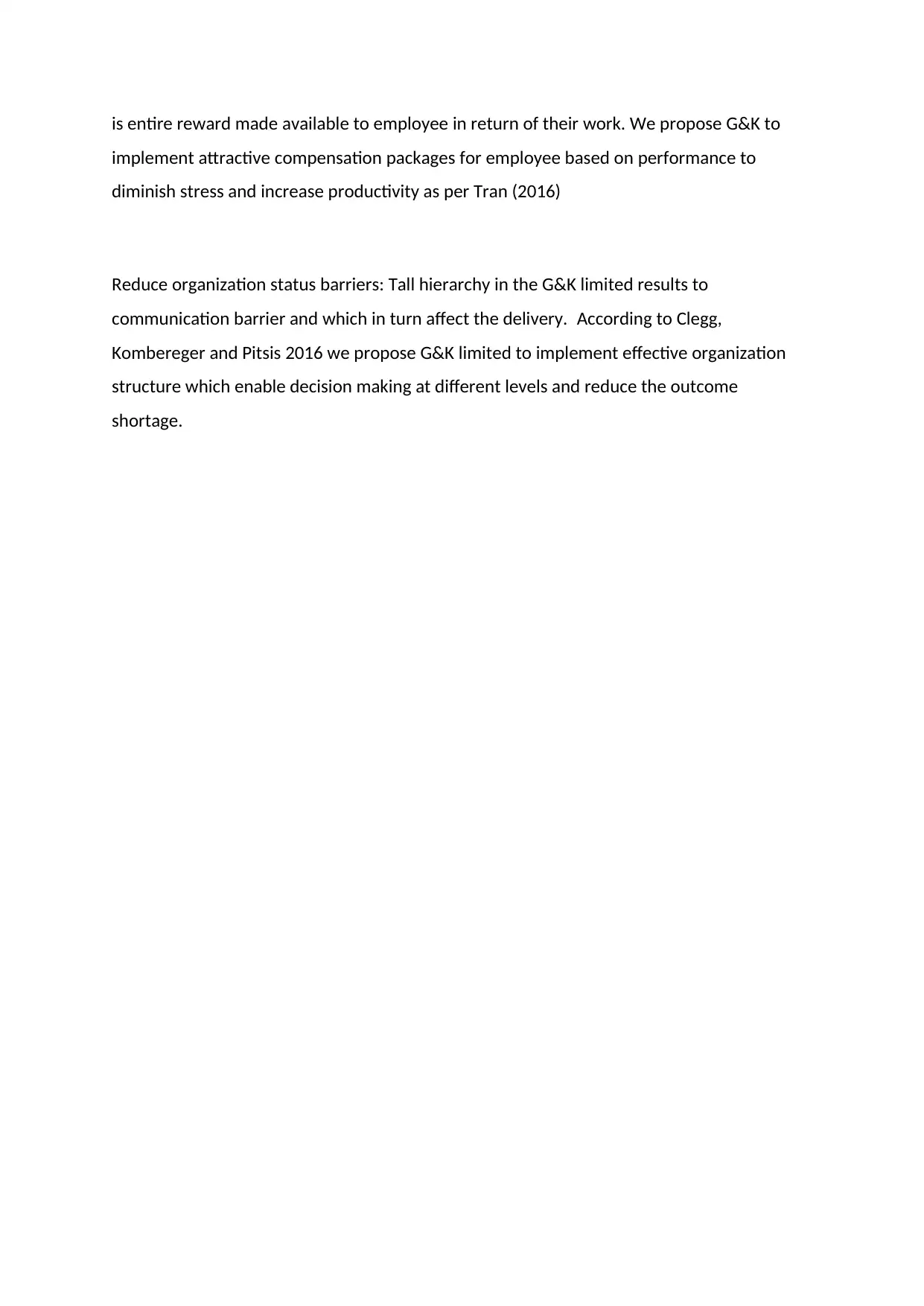
is entire reward made available to employee in return of their work. We propose G&K to
implement attractive compensation packages for employee based on performance to
diminish stress and increase productivity as per Tran (2016)
Reduce organization status barriers: Tall hierarchy in the G&K limited results to
communication barrier and which in turn affect the delivery. According to Clegg,
Kombereger and Pitsis 2016 we propose G&K limited to implement effective organization
structure which enable decision making at different levels and reduce the outcome
shortage.
implement attractive compensation packages for employee based on performance to
diminish stress and increase productivity as per Tran (2016)
Reduce organization status barriers: Tall hierarchy in the G&K limited results to
communication barrier and which in turn affect the delivery. According to Clegg,
Kombereger and Pitsis 2016 we propose G&K limited to implement effective organization
structure which enable decision making at different levels and reduce the outcome
shortage.
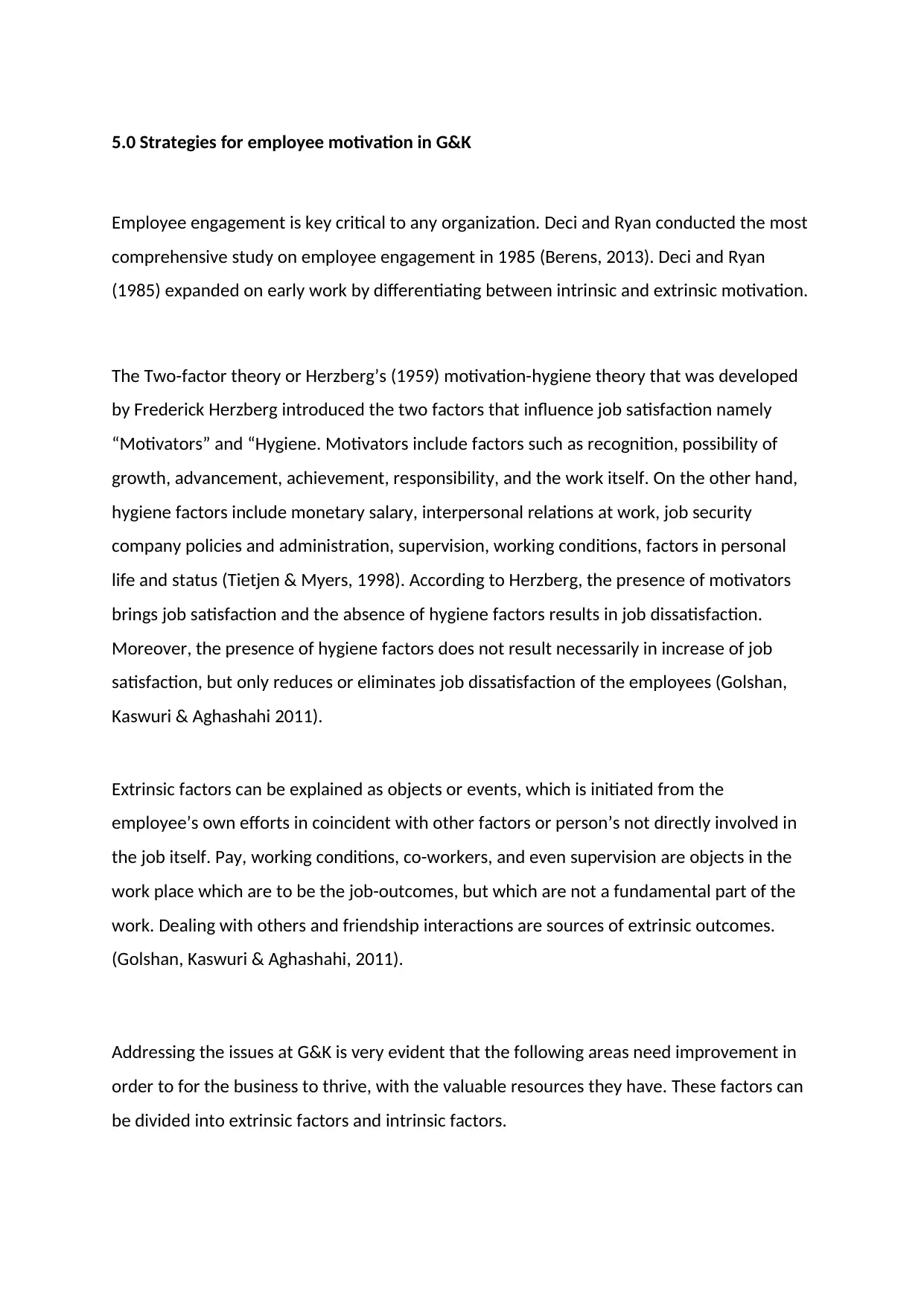
5.0 Strategies for employee motivation in G&K
Employee engagement is key critical to any organization. Deci and Ryan conducted the most
comprehensive study on employee engagement in 1985 (Berens, 2013). Deci and Ryan
(1985) expanded on early work by differentiating between intrinsic and extrinsic motivation.
The Two-factor theory or Herzberg’s (1959) motivation-hygiene theory that was developed
by Frederick Herzberg introduced the two factors that influence job satisfaction namely
“Motivators” and “Hygiene. Motivators include factors such as recognition, possibility of
growth, advancement, achievement, responsibility, and the work itself. On the other hand,
hygiene factors include monetary salary, interpersonal relations at work, job security
company policies and administration, supervision, working conditions, factors in personal
life and status (Tietjen & Myers, 1998). According to Herzberg, the presence of motivators
brings job satisfaction and the absence of hygiene factors results in job dissatisfaction.
Moreover, the presence of hygiene factors does not result necessarily in increase of job
satisfaction, but only reduces or eliminates job dissatisfaction of the employees (Golshan,
Kaswuri & Aghashahi 2011).
Extrinsic factors can be explained as objects or events, which is initiated from the
employee’s own efforts in coincident with other factors or person’s not directly involved in
the job itself. Pay, working conditions, co-workers, and even supervision are objects in the
work place which are to be the job-outcomes, but which are not a fundamental part of the
work. Dealing with others and friendship interactions are sources of extrinsic outcomes.
(Golshan, Kaswuri & Aghashahi, 2011).
Addressing the issues at G&K is very evident that the following areas need improvement in
order to for the business to thrive, with the valuable resources they have. These factors can
be divided into extrinsic factors and intrinsic factors.
Employee engagement is key critical to any organization. Deci and Ryan conducted the most
comprehensive study on employee engagement in 1985 (Berens, 2013). Deci and Ryan
(1985) expanded on early work by differentiating between intrinsic and extrinsic motivation.
The Two-factor theory or Herzberg’s (1959) motivation-hygiene theory that was developed
by Frederick Herzberg introduced the two factors that influence job satisfaction namely
“Motivators” and “Hygiene. Motivators include factors such as recognition, possibility of
growth, advancement, achievement, responsibility, and the work itself. On the other hand,
hygiene factors include monetary salary, interpersonal relations at work, job security
company policies and administration, supervision, working conditions, factors in personal
life and status (Tietjen & Myers, 1998). According to Herzberg, the presence of motivators
brings job satisfaction and the absence of hygiene factors results in job dissatisfaction.
Moreover, the presence of hygiene factors does not result necessarily in increase of job
satisfaction, but only reduces or eliminates job dissatisfaction of the employees (Golshan,
Kaswuri & Aghashahi 2011).
Extrinsic factors can be explained as objects or events, which is initiated from the
employee’s own efforts in coincident with other factors or person’s not directly involved in
the job itself. Pay, working conditions, co-workers, and even supervision are objects in the
work place which are to be the job-outcomes, but which are not a fundamental part of the
work. Dealing with others and friendship interactions are sources of extrinsic outcomes.
(Golshan, Kaswuri & Aghashahi, 2011).
Addressing the issues at G&K is very evident that the following areas need improvement in
order to for the business to thrive, with the valuable resources they have. These factors can
be divided into extrinsic factors and intrinsic factors.
⊘ This is a preview!⊘
Do you want full access?
Subscribe today to unlock all pages.

Trusted by 1+ million students worldwide
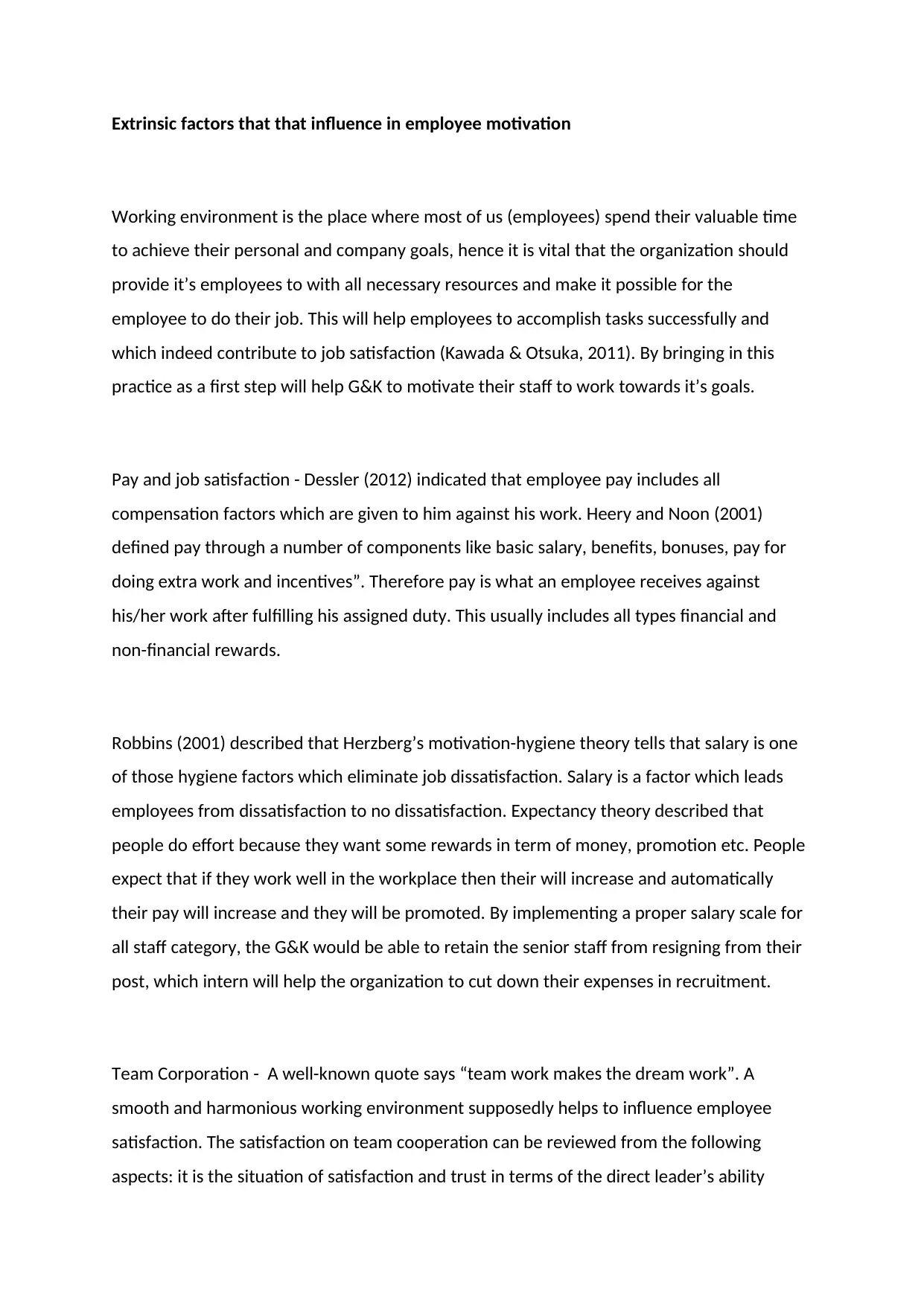
Extrinsic factors that that influence in employee motivation
Working environment is the place where most of us (employees) spend their valuable time
to achieve their personal and company goals, hence it is vital that the organization should
provide it’s employees to with all necessary resources and make it possible for the
employee to do their job. This will help employees to accomplish tasks successfully and
which indeed contribute to job satisfaction (Kawada & Otsuka, 2011). By bringing in this
practice as a first step will help G&K to motivate their staff to work towards it’s goals.
Pay and job satisfaction - Dessler (2012) indicated that employee pay includes all
compensation factors which are given to him against his work. Heery and Noon (2001)
defined pay through a number of components like basic salary, benefits, bonuses, pay for
doing extra work and incentives”. Therefore pay is what an employee receives against
his/her work after fulfilling his assigned duty. This usually includes all types financial and
non-financial rewards.
Robbins (2001) described that Herzberg’s motivation-hygiene theory tells that salary is one
of those hygiene factors which eliminate job dissatisfaction. Salary is a factor which leads
employees from dissatisfaction to no dissatisfaction. Expectancy theory described that
people do effort because they want some rewards in term of money, promotion etc. People
expect that if they work well in the workplace then their will increase and automatically
their pay will increase and they will be promoted. By implementing a proper salary scale for
all staff category, the G&K would be able to retain the senior staff from resigning from their
post, which intern will help the organization to cut down their expenses in recruitment.
Team Corporation - A well-known quote says “team work makes the dream work”. A
smooth and harmonious working environment supposedly helps to influence employee
satisfaction. The satisfaction on team cooperation can be reviewed from the following
aspects: it is the situation of satisfaction and trust in terms of the direct leader’s ability
Working environment is the place where most of us (employees) spend their valuable time
to achieve their personal and company goals, hence it is vital that the organization should
provide it’s employees to with all necessary resources and make it possible for the
employee to do their job. This will help employees to accomplish tasks successfully and
which indeed contribute to job satisfaction (Kawada & Otsuka, 2011). By bringing in this
practice as a first step will help G&K to motivate their staff to work towards it’s goals.
Pay and job satisfaction - Dessler (2012) indicated that employee pay includes all
compensation factors which are given to him against his work. Heery and Noon (2001)
defined pay through a number of components like basic salary, benefits, bonuses, pay for
doing extra work and incentives”. Therefore pay is what an employee receives against
his/her work after fulfilling his assigned duty. This usually includes all types financial and
non-financial rewards.
Robbins (2001) described that Herzberg’s motivation-hygiene theory tells that salary is one
of those hygiene factors which eliminate job dissatisfaction. Salary is a factor which leads
employees from dissatisfaction to no dissatisfaction. Expectancy theory described that
people do effort because they want some rewards in term of money, promotion etc. People
expect that if they work well in the workplace then their will increase and automatically
their pay will increase and they will be promoted. By implementing a proper salary scale for
all staff category, the G&K would be able to retain the senior staff from resigning from their
post, which intern will help the organization to cut down their expenses in recruitment.
Team Corporation - A well-known quote says “team work makes the dream work”. A
smooth and harmonious working environment supposedly helps to influence employee
satisfaction. The satisfaction on team cooperation can be reviewed from the following
aspects: it is the situation of satisfaction and trust in terms of the direct leader’s ability
Paraphrase This Document
Need a fresh take? Get an instant paraphrase of this document with our AI Paraphraser
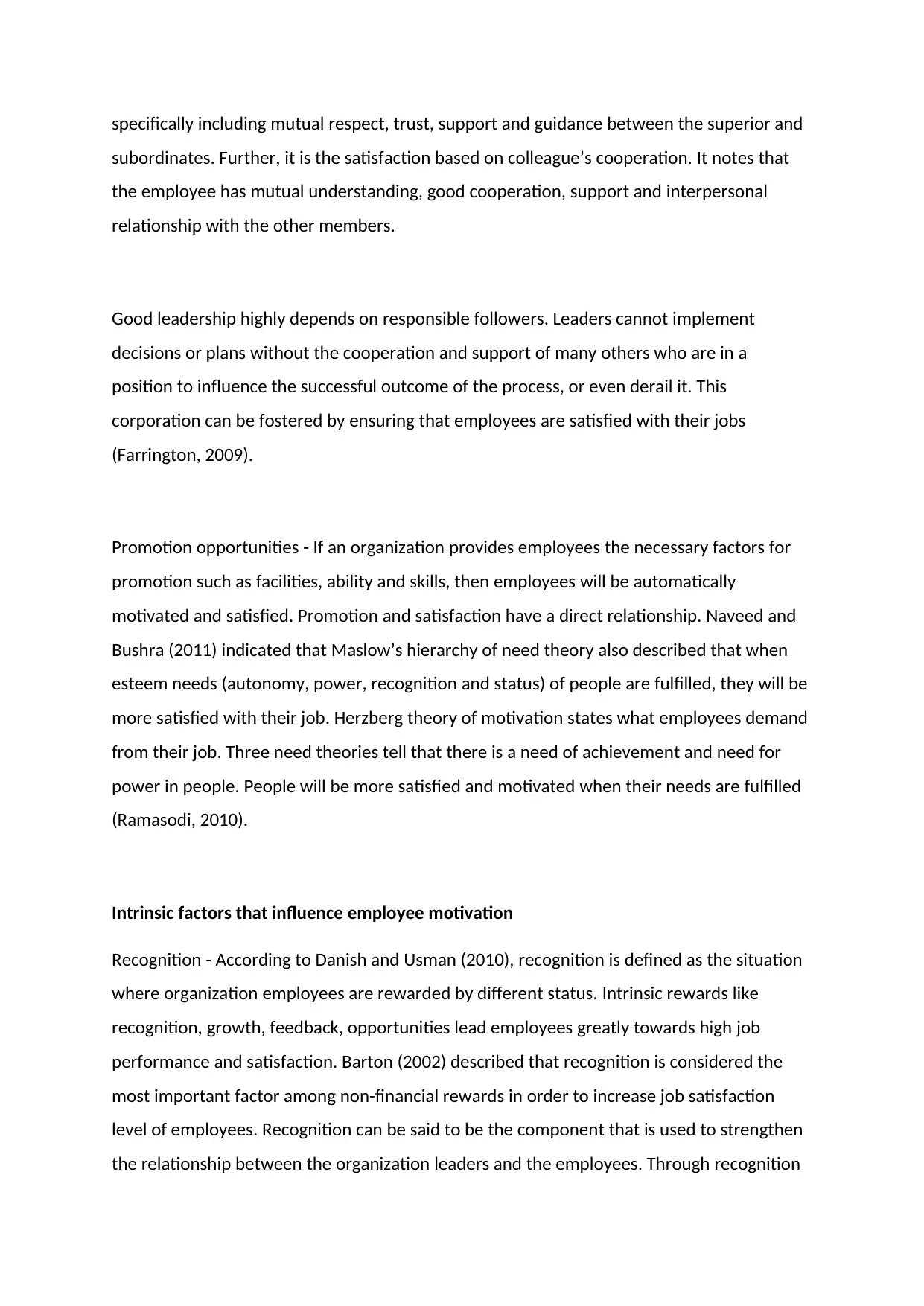
specifically including mutual respect, trust, support and guidance between the superior and
subordinates. Further, it is the satisfaction based on colleague’s cooperation. It notes that
the employee has mutual understanding, good cooperation, support and interpersonal
relationship with the other members.
Good leadership highly depends on responsible followers. Leaders cannot implement
decisions or plans without the cooperation and support of many others who are in a
position to influence the successful outcome of the process, or even derail it. This
corporation can be fostered by ensuring that employees are satisfied with their jobs
(Farrington, 2009).
Promotion opportunities - If an organization provides employees the necessary factors for
promotion such as facilities, ability and skills, then employees will be automatically
motivated and satisfied. Promotion and satisfaction have a direct relationship. Naveed and
Bushra (2011) indicated that Maslow’s hierarchy of need theory also described that when
esteem needs (autonomy, power, recognition and status) of people are fulfilled, they will be
more satisfied with their job. Herzberg theory of motivation states what employees demand
from their job. Three need theories tell that there is a need of achievement and need for
power in people. People will be more satisfied and motivated when their needs are fulfilled
(Ramasodi, 2010).
Intrinsic factors that influence employee motivation
Recognition - According to Danish and Usman (2010), recognition is defined as the situation
where organization employees are rewarded by different status. Intrinsic rewards like
recognition, growth, feedback, opportunities lead employees greatly towards high job
performance and satisfaction. Barton (2002) described that recognition is considered the
most important factor among non-financial rewards in order to increase job satisfaction
level of employees. Recognition can be said to be the component that is used to strengthen
the relationship between the organization leaders and the employees. Through recognition
subordinates. Further, it is the satisfaction based on colleague’s cooperation. It notes that
the employee has mutual understanding, good cooperation, support and interpersonal
relationship with the other members.
Good leadership highly depends on responsible followers. Leaders cannot implement
decisions or plans without the cooperation and support of many others who are in a
position to influence the successful outcome of the process, or even derail it. This
corporation can be fostered by ensuring that employees are satisfied with their jobs
(Farrington, 2009).
Promotion opportunities - If an organization provides employees the necessary factors for
promotion such as facilities, ability and skills, then employees will be automatically
motivated and satisfied. Promotion and satisfaction have a direct relationship. Naveed and
Bushra (2011) indicated that Maslow’s hierarchy of need theory also described that when
esteem needs (autonomy, power, recognition and status) of people are fulfilled, they will be
more satisfied with their job. Herzberg theory of motivation states what employees demand
from their job. Three need theories tell that there is a need of achievement and need for
power in people. People will be more satisfied and motivated when their needs are fulfilled
(Ramasodi, 2010).
Intrinsic factors that influence employee motivation
Recognition - According to Danish and Usman (2010), recognition is defined as the situation
where organization employees are rewarded by different status. Intrinsic rewards like
recognition, growth, feedback, opportunities lead employees greatly towards high job
performance and satisfaction. Barton (2002) described that recognition is considered the
most important factor among non-financial rewards in order to increase job satisfaction
level of employees. Recognition can be said to be the component that is used to strengthen
the relationship between the organization leaders and the employees. Through recognition
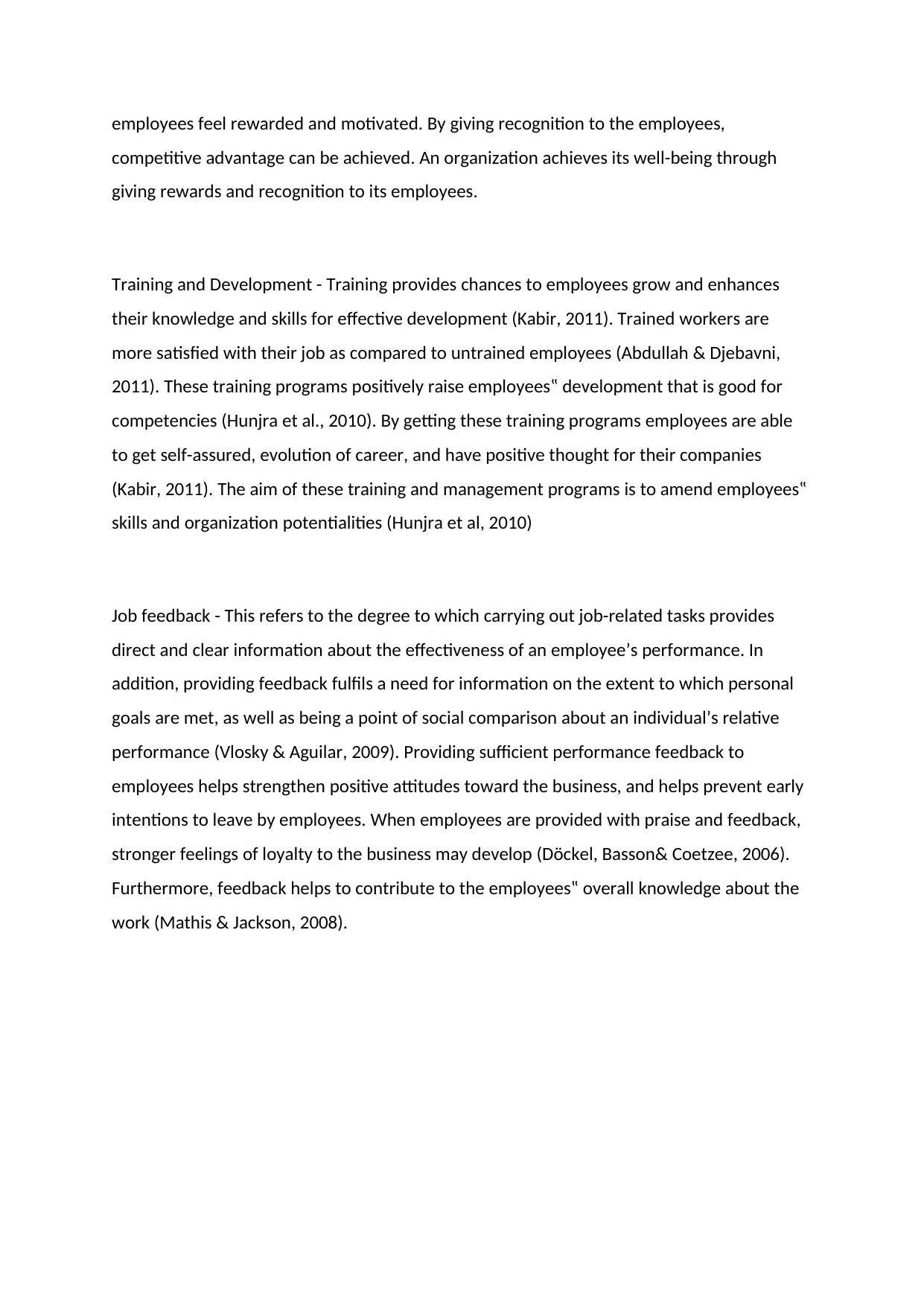
employees feel rewarded and motivated. By giving recognition to the employees,
competitive advantage can be achieved. An organization achieves its well-being through
giving rewards and recognition to its employees.
Training and Development - Training provides chances to employees grow and enhances
their knowledge and skills for effective development (Kabir, 2011). Trained workers are
more satisfied with their job as compared to untrained employees (Abdullah & Djebavni,
2011). These training programs positively raise employees‟ development that is good for
competencies (Hunjra et al., 2010). By getting these training programs employees are able
to get self-assured, evolution of career, and have positive thought for their companies
(Kabir, 2011). The aim of these training and management programs is to amend employees‟
skills and organization potentialities (Hunjra et al, 2010)
Job feedback - This refers to the degree to which carrying out job-related tasks provides
direct and clear information about the effectiveness of an employee’s performance. In
addition, providing feedback fulfils a need for information on the extent to which personal
goals are met, as well as being a point of social comparison about an individual’s relative
performance (Vlosky & Aguilar, 2009). Providing sufficient performance feedback to
employees helps strengthen positive attitudes toward the business, and helps prevent early
intentions to leave by employees. When employees are provided with praise and feedback,
stronger feelings of loyalty to the business may develop (Döckel, Basson& Coetzee, 2006).
Furthermore, feedback helps to contribute to the employees‟ overall knowledge about the
work (Mathis & Jackson, 2008).
competitive advantage can be achieved. An organization achieves its well-being through
giving rewards and recognition to its employees.
Training and Development - Training provides chances to employees grow and enhances
their knowledge and skills for effective development (Kabir, 2011). Trained workers are
more satisfied with their job as compared to untrained employees (Abdullah & Djebavni,
2011). These training programs positively raise employees‟ development that is good for
competencies (Hunjra et al., 2010). By getting these training programs employees are able
to get self-assured, evolution of career, and have positive thought for their companies
(Kabir, 2011). The aim of these training and management programs is to amend employees‟
skills and organization potentialities (Hunjra et al, 2010)
Job feedback - This refers to the degree to which carrying out job-related tasks provides
direct and clear information about the effectiveness of an employee’s performance. In
addition, providing feedback fulfils a need for information on the extent to which personal
goals are met, as well as being a point of social comparison about an individual’s relative
performance (Vlosky & Aguilar, 2009). Providing sufficient performance feedback to
employees helps strengthen positive attitudes toward the business, and helps prevent early
intentions to leave by employees. When employees are provided with praise and feedback,
stronger feelings of loyalty to the business may develop (Döckel, Basson& Coetzee, 2006).
Furthermore, feedback helps to contribute to the employees‟ overall knowledge about the
work (Mathis & Jackson, 2008).
⊘ This is a preview!⊘
Do you want full access?
Subscribe today to unlock all pages.

Trusted by 1+ million students worldwide
1 out of 20
Related Documents
Your All-in-One AI-Powered Toolkit for Academic Success.
+13062052269
info@desklib.com
Available 24*7 on WhatsApp / Email
![[object Object]](/_next/static/media/star-bottom.7253800d.svg)
Unlock your academic potential
Copyright © 2020–2025 A2Z Services. All Rights Reserved. Developed and managed by ZUCOL.





